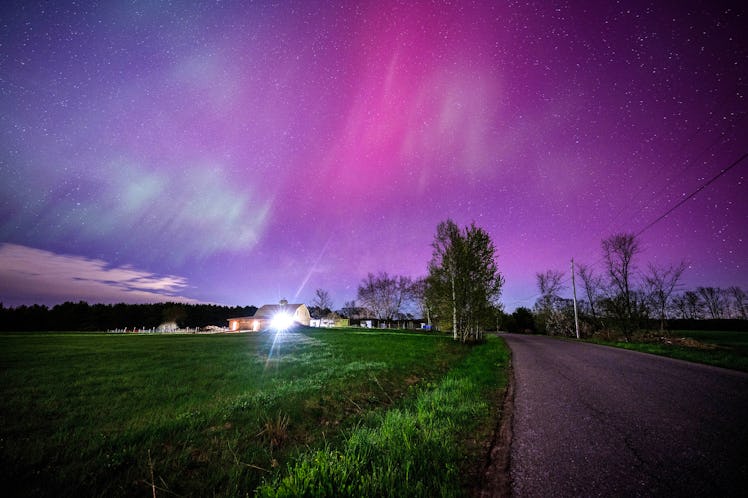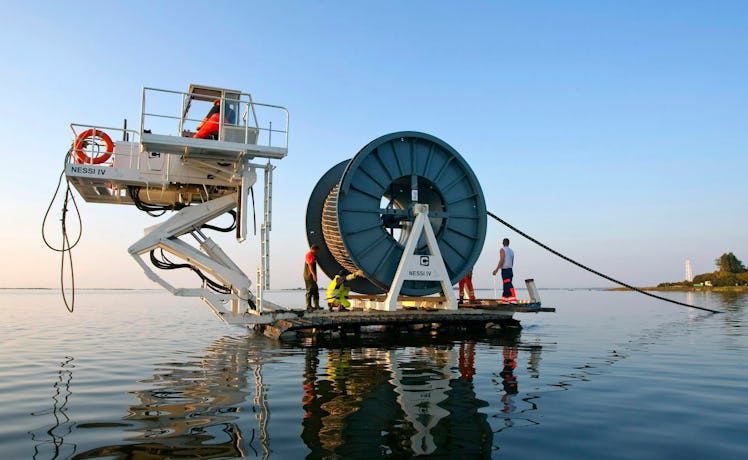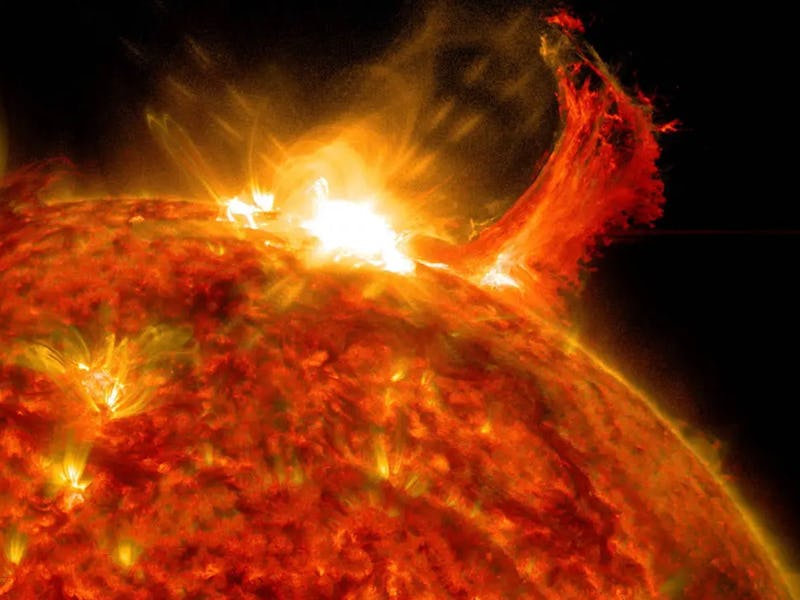SPACE
Footage filmed from several cities across both countries shows an object of "cometary origin" streaking across the sky at around 28 miles per second.
Sunday 19 May 2024

Blue fireball lights up night sky in Spain
A comet fragment lit up the skies over parts of Spain and Portugal overnight - as one person said witnessing the blue fireball "felt like a movie".
The European Space Agency (ESA) shared a video on the X social media platform on Sunday which it says was captured by its "fireball camera".
The agency said the blue light streaking across the sky over the western Spanish city of Caceres was a "stunning meteor" travelling at roughly 28 miles per second.
However, it later said the light was from a "small piece of a comet" and not a meteor.
The comet fragment eventually burned up over the Atlantic Ocean.
"The likelihood of any meteorites being found is very low," the ESA said.
Videos filmed from several cities in Spain and Portugal were circulating on social media.
They showed the comet fragment crossing the sky at high speed and illuminating it in bright tones of blue and green.
NASA has said magnesium creates a blue-green colour when it burns in meteors.
The Spanish Calar Alto astronomical observatory said a preliminary analysis by Andalusia's Institute of Astrophysics revealed the object had a "cometary origin".
CCTV footage released by the mayor's office in the city of Cadiz in southwestern Spain shows the fireball crossing the sky at 12.46am local time (11:46pm UK time).
The fragment was filmed streaking across the sky as a singer performed at a concert in the Portuguese city of Barcelos.
Another video showed the skies of Porto, Portugal's second-biggest city, turning bright for a few seconds.
Many contacted emergency services to report what happened.
A spokesperson for the Spanish Emergency service 112 in Madrid told Europa Press news agency it had received several calls.
Lisbon resident Bernardo Taborda, 31, told Reuters he was walking around the city with friends when the sky suddenly turned bright green: "It almost looked like daylight... we all looked back and saw it."
He added: "It felt like a movie, we all looked at each other and we were stunned.
"It was amazing."
How Solar Storms Can Shut Down The Internet, Power Grids, And Even Tractors
Brace yourself.
BYDAVID WALLACE
GEOMAGNETIC STORMS
Stronger solar storms have happened, and one caused havoc with one of the earliest electronic technologies. On Sept. 1 and 2, 1859, telegraph systems around the world failed catastrophically. The operators of the telegraphs reported receiving electrical shocks, telegraph paper catching fire, and being able to operate equipment with batteries disconnected. During the evenings, the aurora borealis could be seen as far south as Colombia. Typically, these lights are only visible at higher latitudes in northern Canada, Scandinavia, and Siberia.
What the world experienced that day, now known as the Carrington Event, was the largest recorded account of a geomagnetic storm, far stronger than the May 2024 storm.

KNOCKING OUT POWER
Today, a geomagnetic storm of the same intensity as the Carrington Event would affect far more than telegraph wires and could be catastrophic. With the ever-growing dependency on electricity and emerging technology, any disruption could lead to trillions of dollars of monetary loss and risk to life dependent on the systems. The storm would affect a majority of the electrical systems that people use every day.
Geomagnetic storms generate induced currents, which flow through the electrical grid. The geomagnetically induced currents, which can be in excess of 100 amperes, flow into the electrical components connected to the grid, such as transformers, relays and sensors. One hundred amperes is equivalent to the electrical service provided to many households. Currents of this size can cause internal damage to the components, leading to large-scale power outages.
A geomagnetic storm three times smaller than the Carrington Event occurred in Quebec, Canada, in March 1989. The storm caused the Hydro-Quebec electrical grid to collapse. During the storm, the high magnetically induced currents damaged a transformer in New Jersey and tripped the grid’s circuit breakers. In this case, the outage led to five million people being without power for nine hours.
BREAKING CONNECTIONS
In addition to electrical failures, communications would be disrupted on a worldwide scale. Internet service providers could go down, which in turn would take out the ability of different systems to communicate with each other. High-frequency communication systems such as ground-to-air, shortwave, and ship-to-shore radio would be disrupted. Satellites in orbit around the Earth could be damaged by induced currents from the geomagnetic storm burning out their circuit boards. This would lead to disruptions in satellite-based telephone, internet, radio, and television.
Also, as geomagnetic storms hit the Earth, the increase in solar activity causes the atmosphere to expand outward. This expansion changes the density of the atmosphere where satellites are orbiting. Higher density atmosphere creates drag on a satellite, which slows it down. And if it isn’t maneuvered to a higher orbit, it can fall back to Earth.
Another area of disruption that could potentially affect everyday life is navigation systems. Virtually every mode of transportation, from cars to airplanes, uses GPS for navigation and tracking. Even handheld devices such as cell phones, smartwatches, and tracking tags rely on GPS signals sent from satellites. Military systems are heavily dependent on GPS for coordination. Other military detection systems, such as over-the-horizon radar and submarine detection systems, could be disrupted, which would hamper national defense.

The global internet is held together by a network of cables crisscrossing the world’s oceans.JENS KÖHLER/ULLSTEIN BILD VIA GETTY IMAGES
In terms of the Internet, a geomagnetic storm on the scale of the Carrington Event could produce geomagnetically induced currents in the submarine and terrestrial cables that form the backbone of the Internet as well as the data centers that store and process everything from email and text messages to scientific data sets and artificial intelligence tools. This would potentially disrupt the entire network and prevent the servers from connecting to each other.
JUST A MATTER OF TIME
It is only a matter of time before the Earth is hit by another big geomagnetic storm. A Carrington Event-size storm would be extremely damaging to the electrical and communication systems worldwide, with outages lasting for weeks. If the storm is the size of the Miyake Event, the results would be catastrophic for the world, with potential outages lasting months, if not longer. Even with space weather warnings from NOAA's Space Weather Prediction Center, the world would have only a few minutes to a few hour's notice.
I believe it is critical to continue researching ways to protect electrical systems against the effects of geomagnetic storms, for example, by installing devices that can shield vulnerable equipment like transformers and by developing strategies for adjusting grid loads when solar storms are about to hit. In short, it's important to work now to minimize the disruptions from the next Carrington Event.
This article was originally published on The Conversation by David Wallace at Mississippi State University. Read the original article here.
Brace yourself.
BYDAVID WALLACE
THE CONVERSATION
3 HOURS AGO

3 HOURS AGO

NASA/SDO
The geomagnetic storm that began on May 10, 2024, generated stunning aurora borealis, more commonly known as the northern lights, that could be seen as far south as Mexico. They also generated headaches for farmers whose GPS-guided tractors were idled in the middle of planting season.
Geomagnetic storms occur when a large bubble of superheated gas called plasma is ejected from the surface of the Sun and hits the Earth. This bubble is known as a coronal mass ejection. The plasma of a coronal mass ejection consists of a cloud of protons and electrons, which are electrically charged particles. When these particles reach the Earth, they interact with the magnetic field that surrounds the planet. This interaction causes the magnetic field to distort and weaken, which in turn leads to the strange behavior of the aurora borealis and other natural phenomena.
The May 2024 storm, rated G5 on the National Oceanic and Atmospheric Administration’s 1-to-5 Geomagnetic Storms scale, disrupted GPS communications enough to throw off tractor guidance, which requires centimeter-level precision. Stronger storms would have much more serious consequences. As an electrical engineer who specializes in the power grid, I study how geomagnetic storms also threaten to cause power and internet outages and how to protect against that.
The geomagnetic storm that began on May 10, 2024, generated stunning aurora borealis, more commonly known as the northern lights, that could be seen as far south as Mexico. They also generated headaches for farmers whose GPS-guided tractors were idled in the middle of planting season.
Geomagnetic storms occur when a large bubble of superheated gas called plasma is ejected from the surface of the Sun and hits the Earth. This bubble is known as a coronal mass ejection. The plasma of a coronal mass ejection consists of a cloud of protons and electrons, which are electrically charged particles. When these particles reach the Earth, they interact with the magnetic field that surrounds the planet. This interaction causes the magnetic field to distort and weaken, which in turn leads to the strange behavior of the aurora borealis and other natural phenomena.
The May 2024 storm, rated G5 on the National Oceanic and Atmospheric Administration’s 1-to-5 Geomagnetic Storms scale, disrupted GPS communications enough to throw off tractor guidance, which requires centimeter-level precision. Stronger storms would have much more serious consequences. As an electrical engineer who specializes in the power grid, I study how geomagnetic storms also threaten to cause power and internet outages and how to protect against that.
GEOMAGNETIC STORMS
Stronger solar storms have happened, and one caused havoc with one of the earliest electronic technologies. On Sept. 1 and 2, 1859, telegraph systems around the world failed catastrophically. The operators of the telegraphs reported receiving electrical shocks, telegraph paper catching fire, and being able to operate equipment with batteries disconnected. During the evenings, the aurora borealis could be seen as far south as Colombia. Typically, these lights are only visible at higher latitudes in northern Canada, Scandinavia, and Siberia.
What the world experienced that day, now known as the Carrington Event, was the largest recorded account of a geomagnetic storm, far stronger than the May 2024 storm.

MICHAEL SEAMANS/GETTY IMAGES NEWS/GETTY IMAGES
Geomagnetic storms have been recorded since the early 19th century, and scientific data from Antarctic ice core samples has shown evidence of an even more massive geomagnetic storm that occurred around A.D. 774, known as the Miyake Event. That solar flare produced the largest and fastest rise in carbon-14 ever recorded. Geomagnetic storms trigger high amounts of cosmic rays in Earth’s upper atmosphere, which in turn produce carbon-14, a radioactive isotope of carbon.
A geomagnetic storm 60% smaller than the Miyake Event occurred around A.D. 993. Ice core samples have shown evidence that large-scale geomagnetic storms with similar intensities as the Miyake and Carrington events occur at an average rate of once every 500 years.
Scientists were able to estimate the strength of the Carrington Event based on the fluctuations of Earth’s magnetic field as recorded by observatories at the time. There was no way to measure the magnetic fluctuation of the Miyake Event. Instead, scientists measured the increase in carbon-14 in tree rings from that time period. The Miyake Event produced a 12% increase in carbon-14. By comparison, the Carrington Event produced less than a 1% increase in carbon-14, so the Miyake Event likely dwarfed the G5 Carrington Event.
Geomagnetic storms have been recorded since the early 19th century, and scientific data from Antarctic ice core samples has shown evidence of an even more massive geomagnetic storm that occurred around A.D. 774, known as the Miyake Event. That solar flare produced the largest and fastest rise in carbon-14 ever recorded. Geomagnetic storms trigger high amounts of cosmic rays in Earth’s upper atmosphere, which in turn produce carbon-14, a radioactive isotope of carbon.
A geomagnetic storm 60% smaller than the Miyake Event occurred around A.D. 993. Ice core samples have shown evidence that large-scale geomagnetic storms with similar intensities as the Miyake and Carrington events occur at an average rate of once every 500 years.
Scientists were able to estimate the strength of the Carrington Event based on the fluctuations of Earth’s magnetic field as recorded by observatories at the time. There was no way to measure the magnetic fluctuation of the Miyake Event. Instead, scientists measured the increase in carbon-14 in tree rings from that time period. The Miyake Event produced a 12% increase in carbon-14. By comparison, the Carrington Event produced less than a 1% increase in carbon-14, so the Miyake Event likely dwarfed the G5 Carrington Event.
KNOCKING OUT POWER
Today, a geomagnetic storm of the same intensity as the Carrington Event would affect far more than telegraph wires and could be catastrophic. With the ever-growing dependency on electricity and emerging technology, any disruption could lead to trillions of dollars of monetary loss and risk to life dependent on the systems. The storm would affect a majority of the electrical systems that people use every day.
Geomagnetic storms generate induced currents, which flow through the electrical grid. The geomagnetically induced currents, which can be in excess of 100 amperes, flow into the electrical components connected to the grid, such as transformers, relays and sensors. One hundred amperes is equivalent to the electrical service provided to many households. Currents of this size can cause internal damage to the components, leading to large-scale power outages.
A geomagnetic storm three times smaller than the Carrington Event occurred in Quebec, Canada, in March 1989. The storm caused the Hydro-Quebec electrical grid to collapse. During the storm, the high magnetically induced currents damaged a transformer in New Jersey and tripped the grid’s circuit breakers. In this case, the outage led to five million people being without power for nine hours.
BREAKING CONNECTIONS
In addition to electrical failures, communications would be disrupted on a worldwide scale. Internet service providers could go down, which in turn would take out the ability of different systems to communicate with each other. High-frequency communication systems such as ground-to-air, shortwave, and ship-to-shore radio would be disrupted. Satellites in orbit around the Earth could be damaged by induced currents from the geomagnetic storm burning out their circuit boards. This would lead to disruptions in satellite-based telephone, internet, radio, and television.
Also, as geomagnetic storms hit the Earth, the increase in solar activity causes the atmosphere to expand outward. This expansion changes the density of the atmosphere where satellites are orbiting. Higher density atmosphere creates drag on a satellite, which slows it down. And if it isn’t maneuvered to a higher orbit, it can fall back to Earth.
Another area of disruption that could potentially affect everyday life is navigation systems. Virtually every mode of transportation, from cars to airplanes, uses GPS for navigation and tracking. Even handheld devices such as cell phones, smartwatches, and tracking tags rely on GPS signals sent from satellites. Military systems are heavily dependent on GPS for coordination. Other military detection systems, such as over-the-horizon radar and submarine detection systems, could be disrupted, which would hamper national defense.

The global internet is held together by a network of cables crisscrossing the world’s oceans.JENS KÖHLER/ULLSTEIN BILD VIA GETTY IMAGES
In terms of the Internet, a geomagnetic storm on the scale of the Carrington Event could produce geomagnetically induced currents in the submarine and terrestrial cables that form the backbone of the Internet as well as the data centers that store and process everything from email and text messages to scientific data sets and artificial intelligence tools. This would potentially disrupt the entire network and prevent the servers from connecting to each other.
JUST A MATTER OF TIME
It is only a matter of time before the Earth is hit by another big geomagnetic storm. A Carrington Event-size storm would be extremely damaging to the electrical and communication systems worldwide, with outages lasting for weeks. If the storm is the size of the Miyake Event, the results would be catastrophic for the world, with potential outages lasting months, if not longer. Even with space weather warnings from NOAA's Space Weather Prediction Center, the world would have only a few minutes to a few hour's notice.
I believe it is critical to continue researching ways to protect electrical systems against the effects of geomagnetic storms, for example, by installing devices that can shield vulnerable equipment like transformers and by developing strategies for adjusting grid loads when solar storms are about to hit. In short, it's important to work now to minimize the disruptions from the next Carrington Event.
This article was originally published on The Conversation by David Wallace at Mississippi State University. Read the original article here.
No comments:
Post a Comment